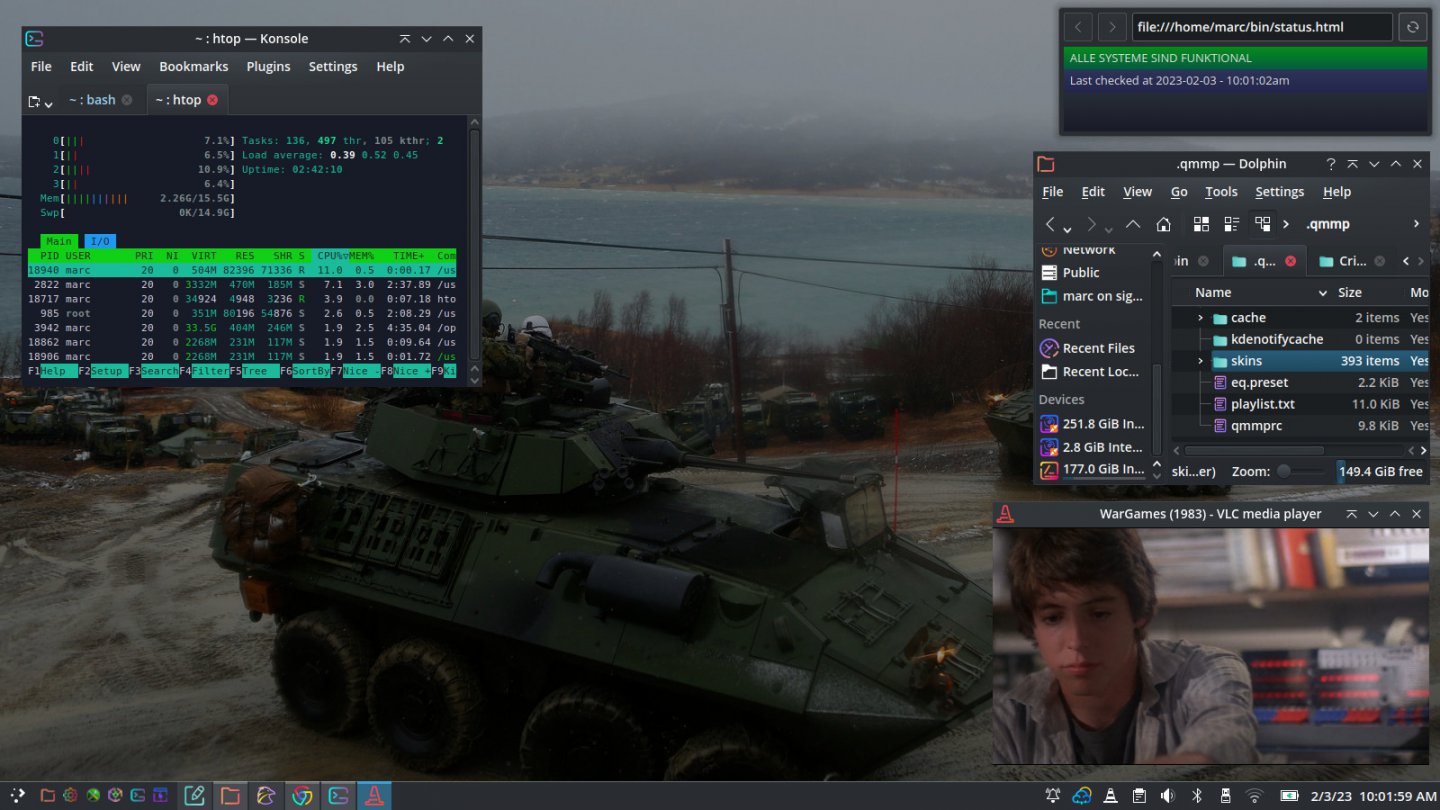From my Notebook >
I Installed PCLinuxOS and I Like It So Far. Here's Why

Above: A screenshot of my new PCLinuxOS desktop, showing HTOP running in Konsole, the Dolphin file manager, VLC playing a video, and a KDE web browser Widget showing my makeshift genmon-replacement status page.
So I had an older laptop (T420) on my hands, and needed to make a decision. Do I…
- Keep the existing Linux install: Ubuntu 18.04 LTS, or Upgrade It?
- Install Haiku OS once more, as some of my Mastodon account followers seemed to favor?
- Install another OS or Linux Distro?
This led me to…
A System Decisionmaking Process
Each option was really tempting:
The existing install of Ubuntu 18.04 had everything just how I liked it. From XFCE settings, to system-wide shortcuts, to my favorite weird software packages installed and ready, to LAN synchronization and configuration, and so on. However, it was outdated, and I’m not 100% comfortable with “just freeze updates & retrocompute” on a system that’s still very capable, with 16GB RAM and an SSD.
Regarding Haiku OS, I really like it. I enjoyed learning more about it last time. But I remembered having some trouble with dual-booting Windows in the past, mostly due to some kind of installer issue, or maybe an installer-comprehension issue. The Windows install on this laptop has tons of weird and hard-to-find ham radio driver / configuration software on it. So I was really not wanting to mess around with the possibility of removing Windows by mistake. (Otherwise, how would I run GRPC8810 which is the no-longer-published configuration software for the 100W handheld waterproof GPS ham radio I bought for $45 off Aliexpress??? …OK, I’m joking…a bit…kind of…)
I looked at some other Linux distros, and there are quite a few that I remember using before, and that I really enjoyed. There were also some that I hadn’t used before, that I wanted to.
Some of the distros I didn’t get to try this time, but that I really want to try (or try again) sometime, include:
- Slax (I used to love using Slax in like…2004? Wow it’s been a long time)
- Mageia
- MX Linux (tried before & liked it)
- Linux Mint (tried long ago & liked it)
I have also been wanting to try Dyne:Bolic again as well, as it’s been more than a decade since I last tried it.
By the way—I’m really surprised that so many of these distros are still going! What a friggin huge thing we have, in the Linux user community. It’s impressive that these are mostly community projects with little or nothing in terms of incoming corporate support.
Finally, I remembered trying out PCLinuxOS a Looooong time ago and I recall being very impressed by it at the time.
I like that PCLinuxOS uses Synaptic Package Manager, which is now very much part of my muscle memory after using Ubuntu and other distros so much in the early 2000s.
It also uses the community-forum-pinned-message-support model, which I am used to from other software communities.
Plus, there’s a feeling of “desktop user sensibility” to the distro which is hard to explain without going into tons of other distros. But to me, PCLinuxOS felt like coming home, in a lot of ways.
The maintainers now make a PCLinuxOS “DarkStar” version available, which is slightly smaller to download, and I had passed my ISP bandwidth limit last month. So, still smarting from that annoying bandwidth experience, I downloaded DarkStar, backed up my Ubuntu 18.04 files, and got started with the install.
Installing PCLinuxOS
Installing PCLinuxOS was mostly very easy, and I only encountered two issues:
- The installer confirms which partition (sdaX) it’s going to install to, but it doesn’t show any “sdaX” labels on the previous screen where it shows, graphically, which partitions it found on your system. So I ended up guessing that I wasn’t overwriting my Windows partition, but I was “pretty sure”…
- Some important messages in the installer are tersely worded. There’s a message like “Probe for other OS” next to a checkbox, and what this really means is “if you ever want to use Windows again, check this box or you’l be in for an annoying experience.” (I am glad I did a bit of forum surfing beforehand and came across someone who did not check the box.)
Loading Up on New Learning
I made sure to read the PCLinuxOS FAQ, which covered some important lessons really quickly.
I also started browsing through the community forum, getting a feel for the stickied content (i.e. important issues that users encounter over and over) and also the most recent content (i.e. issues that may be relevant to my newer version of the distribution).
Evaluating the Experience
Here are some things I really like about PCLinuxOS, after getting it set up:
- The GRUB boot menu looks way better than my Ubuntu ones do. Why is that? I never understood this aspect, but a lot of smaller distros have way nicer boot visuals than Ubuntu.
- Things seem well-tested, and the system and desktop (I’m using KDE here after many years) are easy to use and nicely configured.
- The packages are indeed kept new and fresh, especially compared to an LTS distro. The PCLinuxOS distro maintainers seem proud of this, and rightly so.
- There are unique, convenient, distro maintainer “affordances” for users, for example the PCLinuxOS Control Center, with convenient tools for setting up various aspects of the user experience.
- There’s also an interesting forum thread which identifies a bunch of the PCLinuxOS GUI Utilities which have been created for users’ benefit.
- The software I use is mostly available in the repository (I would say “repositories” but there is just one, and they advise you NOT to add third-party repos at all).
- Some minor exceptions (DCSS was one I found missing) can be found on the web as AppImages, so they are easy to set up. Flatpak, Wine, and compile-from-source methods are also supported.
- There is a PCLinuxOS magazine that is distributed via PDF, which I always thought was impressive.
- Community feel: There isn’t a corporate feel and the community seems supportive enough.
Some dislikes:
- The frequency of updates needed seems quite high compared to non-rolling-release distros. I admit this is a bit jarring to someone who may leave a laptop on a shelf for a while, when life gets in the way.
- The white parts of my desktop were suddenly very pink. Oh no! What happened to my laptop screen…? Then I remembered…a while back these “evening color adjustment” apps were really popular. So I typed “Color” and “Colors” came up and—yep, that was it.
- Still, I wanted a little bit more warmth in my blue-ish screen colors in general, so I kept it turned on and changed the color temperature to my liking.
- NTP time sync didn’t work as I expected. Not sure why.
- The login screen / greeter is kind of strange to me. It has a lot of information and wants me to type my username before I type my password, but there’s only one username and it already looks like it’s selected. (Result: I type my password in cleartext, when I should be typing my username. Hah)
- KDE-Specific: KDE settings are spread around everywhere.
- Using KDE is like a settings-safari. It’s amazing and overpowering at the same time.
- You can customize KDE so much that you may feel practically insulted when you find out some customizing aspect is missing, e.g. there’s no genmon-equivalent, which I used quite a bit in XFCE!
I am thinking there are workarounds for all of this though, and I don’t mind workaround-ing.
Planning for the Future
I do have a bunch of questions for the future, as I continue to use this system:
- How can I get back most of my XFCE keyboard shortcuts and genmon-style panel tools? I had a very customized desktop. (And I guess my question is more “how much of that will I keep, and migrate to KDE, which seems painful” and less “how do I copy my old dotfiles?”)
- What are the WORST parts of using a rolling-release distribution?
- I anticipate one of these parts being: Sometimes I don’t use this laptop for 60+ days, and the PCLinuxOS website says this means you need to reinstall completely (Edit: rather, it says that waiting more than 60 days to run an upgrade may break some software, and that you should not wait that long). So…hm. Enable some auto-updater maybe, in case I boot up again within 59 days and forget to update? (Edit: Various members of the PCLOS community responded and said they had no issues with this, even after many months or years)
- In case I need it, how can I make a complete upgrade from USB distro easier on my personal files & settings?
- What are some other distros I should try? This entire process has been pretty enjoyable!
Conclusion
I’ve enjoyed this experience very much. It taught me that I really enjoy trying out Linux Distros and brought me back into touch with that less-boring/stable, but more-“whoa, interesting” part of the Linux user lifestyle.
If you are considering a desktop user Linux distro, I think PCLinuxOS is probably worth a try.

 Friendlyskies.net
Friendlyskies.net